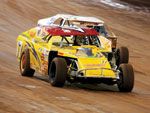
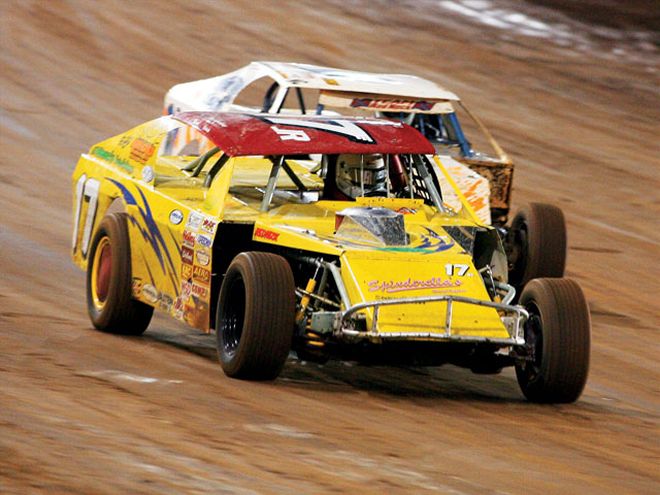 IMCA's claimer rules are so popular that many other series (such as the Southern Modified Tour shown here) have adopted similar measures to keep costs down. When building a claimer engine, the trick is to find a way to make power by building a smart engine instead of an expensive one.
IMCA's claimer rules are so popular that many other series (such as the Southern Modified Tour shown here) have adopted similar measures to keep costs down. When building a claimer engine, the trick is to find a way to make power by building a smart engine instead of an expensive one.
You have to hand it to the IMCA-they really know how to get to the heart of a problem. Almost all sanctioning bodies claim they try to keep the costs in check for their racers, but rules mandating such "low-cost" options as smaller carburetors, steel valves, and heavy cranks are rarely effective.
The IMCA has a rule in its Modified and Stock Car classes that has been in effect for many years now, and while racers have different opinions of it, there is no denying that it has the intended effect of making racers keep a close eye on the checkbook. That rule is, of course, the IMCA's claimer rule, and the best part about it is its simplicity. Essentially, the IMCA lets you run just about anything you want, but anyone on the track who finished below you can claim your engine for $525 or the engine in their car. (Usually, the team getting claimed has the choice of which they want.)
The rule is so successful that many other sanctions use some version of it in their own rule books. Building any race engine for $525 is practically impossible, so the goal for the racer is to get the best engine possible for the least amount of money. When you do that, however, durability becomes an issue as engine builders try to find and use the least expensive components available. It becomes a tricky puzzle trying to balance cost, power, and durability, but for savvy racers, it can be done.
To get some ideas on what's currently going on with top claimer engine packages, we visited some of the top engine builders for these engines as well as IMCA's Vice President of Operations, Brett Root. We also spoke with Kent Davenport, machine shop manager of JR Motorsports; Jeff Hill, owner of Jeff's Performance; and Ken Troutman, owner of KT Engine Development. The following are general tips for this class of racing to help you spend your money smarter, race faster, and race longer without mechanical troubles. We didn't follow any specific rule book, assuming only a very low-cost claimer rule.
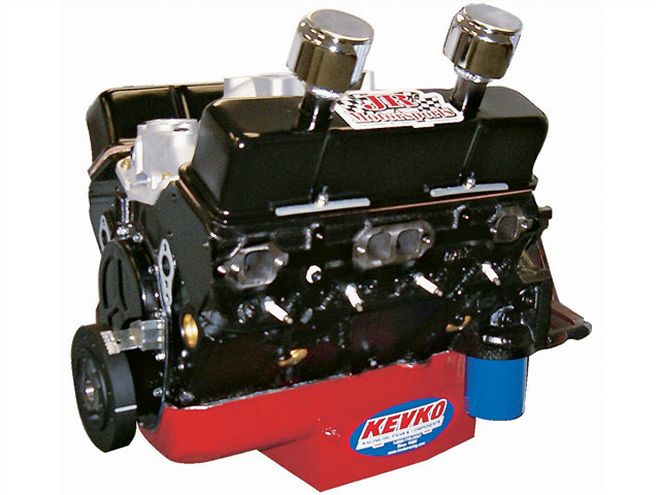 You may think of JR Motorsports as a mail-order racing warehouse, but the company also builds custom race engines and is very successful in the claimer classes. Photo courtesy of JR Motorsports
You may think of JR Motorsports as a mail-order racing warehouse, but the company also builds custom race engines and is very successful in the claimer classes. Photo courtesy of JR Motorsports
Some guys in these classes are doing it economically, and some guys are spending what I think is way too much money. It all comes down to issues of convenience and time. If you don't have the time, you have to spend the money.
In general, what I've noticed is regardless of what they are spending, the racers who have very good maintenance programs are the ones having the most success. They are the ones making sure their valves are right, regularly changing the oil, cutting the oil filter open and checking it for debris-doing basic things to make sure their engines are taken care of. They make sure they have adequate fuel systems, a good water pump, that kind of stuff. Regardless of what they spend, those are the guys who seem to make it work. They run well and run consistently week after week without a lot of problems. I believe that is a big key-not whether you are running a particular connecting rod or whether you are running a forged piston instead of a cast one.
Brett Root
IMCA
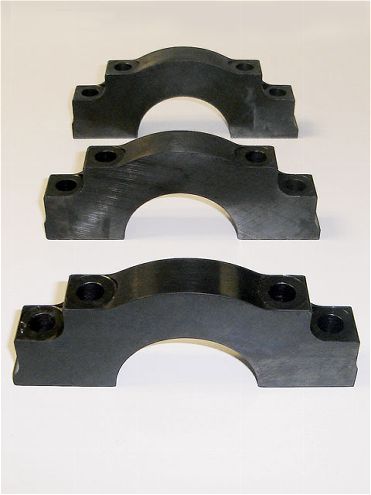 One of the few rules in these classes is that you must run a stock block. Original four-bolt blocks are getting pretty scarce, so JR Motorsports sells a four-bolt main cap set that is easily fitted to a block with two-bolt caps. Minimal machine work is required on the block, and Kent Davenport of JR Motorsports says that almost any competent machine shop can do the work for you. Photo courtesy of JR Motorsports
One of the few rules in these classes is that you must run a stock block. Original four-bolt blocks are getting pretty scarce, so JR Motorsports sells a four-bolt main cap set that is easily fitted to a block with two-bolt caps. Minimal machine work is required on the block, and Kent Davenport of JR Motorsports says that almost any competent machine shop can do the work for you. Photo courtesy of JR Motorsports
You are required to run a stock block. When building a Chevrolet, I still prefer the blocks with the two-piece rear main seals. They are getting tougher to find, but you can still find them with two-bolt main caps.
The problem we run into with two-bolt main caps is racers spin the engines so high that the caps break. Everybody is big on rpm. It has to do with the four-link rear suspensions on the cars. Racers are using engine speed to keep the car up on the bars and keep it moving to get traction.
To eliminate cap breakage, we offer four-bolt caps that can easily fit onto a two-bolt block. It is fairly simple for any machine shop to make the block accept a four-bolt cap. You are going from a cast two-bolt main cap to a much stronger four-bolt billet piece. The caps cost a little bit, but the two-bolt blocks are usually a little cheaper, too. Overall, you may spend more money than if you found a block with four-bolt mains, but you are still getting a stronger piece this way.
Kent Davenport
JR Motorsports
Keep the timing down. Guys like to put a lot of timing in these motors, but that puts a lot of heat in the cylinders. They will definitely make more power with a lot of timing in them, but the engines won't last as long. If you can keep the timing down to around 34 degrees BTDC, or 36 degrees max, that helps a lot. It just helps keep the engine from detonating. And detonation is definitely going to hammer the top of that piston. You might not be able to win every race if you keep the timing down below 36 degrees, but you will be at every race without spending a lot of money.
Jeff Hill
Jeff's Performance
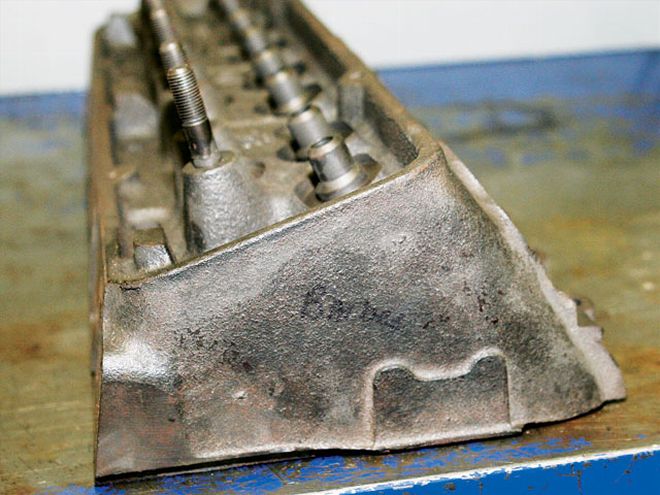 Ken Troutman, owner of KT Engine Development, says that if you are choosing among stock cylinder heads and aren't allowed to use the Vortec, it is still hard to go wrong with Chevrolet's famous "double hump" head. It is so named-and easy to identify-because of the double-hump casting mark on the end of the head.
Ken Troutman, owner of KT Engine Development, says that if you are choosing among stock cylinder heads and aren't allowed to use the Vortec, it is still hard to go wrong with Chevrolet's famous "double hump" head. It is so named-and easy to identify-because of the double-hump casting mark on the end of the head.
Some classes or tracks require you to run stock heads and don't allow Chevy's Vortec head. If that's the case, the best thing you can do is go with the double-hump head. This cylinder head is about as good as a Bow Tie Late Model Stock head because the chambers are so tight and the ports offer decent flow. They also have a good, thick deck so you can cut them down a bit. For a stock cast-iron head, they are hard to beat.
If you have to go hunting in the junkyard, a set of double-hump cylinder heads isn't hard to identify. They are cast with an identifier on the end of the heads that resembles a camel's humps. Just make sure they aren't cracked between the two center exhaust ports.
Ken TroutmanKT Engine Development
As we reach higher rpm levels, I believe there must be some type of harmonic issue with these motors, especially with the bigger strokes. Although we haven't identified the problem, we know that the damper cannot handle it. As a result, we break a lot of oil pump pickup tubes.
We have tried to do away with the OEM small-block oil pump and pickup tube, and we have stepped it up to M77 big-block pumps and even high-volume pumps accompanied by Kevco or Champ Pans pickup tubes. The bigger pickup tube's bracketry holds the oil pickup box right next to the oil pump, which helps. It is a bigger, beefier pump, which structurally is a bit stronger. I think there is less of an opportunity for this oil pump to cavitate, too.
So we have stepped up our program from a small-block oil pump to a big-block pump with a 3?4-inch pickup tube. The high-volume pump doesn't burn too much horsepower. Plus, since the motors are open, we are able to make enough horsepower so that losing a half-dozen horses doesn't really matter. The most important thing is to keep the bearings lubed and keep the pickup tube from breaking off so that you can race again next week.
Kent DavenportJR Motorsports
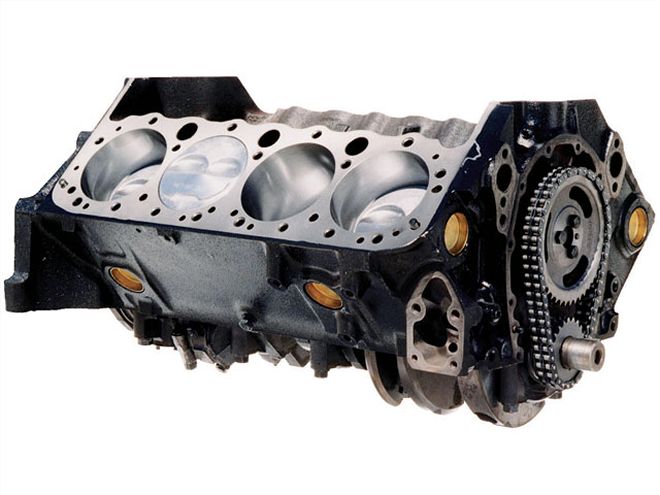 Many companies, such as Jeff's Performance and JR Motorsports, offer entire rotating assembly kits that include everything from the crank to the pistons and can save you a considerable amount of money versus purchasing everything individually. Hill says you can even purchase kits that have the rings already pre-gapped. All you have to do is assemble the parts into your block. Photo courtesy of JR Motorsports
Many companies, such as Jeff's Performance and JR Motorsports, offer entire rotating assembly kits that include everything from the crank to the pistons and can save you a considerable amount of money versus purchasing everything individually. Hill says you can even purchase kits that have the rings already pre-gapped. All you have to do is assemble the parts into your block. Photo courtesy of JR Motorsports
The aftermarket has become aggressive with the pricing of performance cranks and pistons. You can do a lot better with your money by buying a complete rotating assembly in a kit. This way, you know that everything is already matched up to work together.
We now offer a basic economy kit that includes a new crank, rods, pistons, rings, and bearings. It's everything you need for the bottom end of the engine. Our kit costs around $449, so you can save a lot of money versus buying everything individually. The crank is cast steel, the rods are I-beam 4130 steel, and the pistons are hypereutectic. The entire rotating assembly comes already balanced, and the rings are already file fit, so everything is ready to be assembled. All you need is the block and the oil pan.
We don't recommend a cast piston, but we've had really good luck the last few years using hypereutectic pistons, which will save you a lot of money over forged pistons. There is no power difference between a forged and a hypereutectic piston, just the strength. They work very well unless you drop a valve, which will shatter the piston. So you have to keep on top of your valves and springs. Many people have two seasons on the kits we've been selling.
Jeff HillJeff's Performance
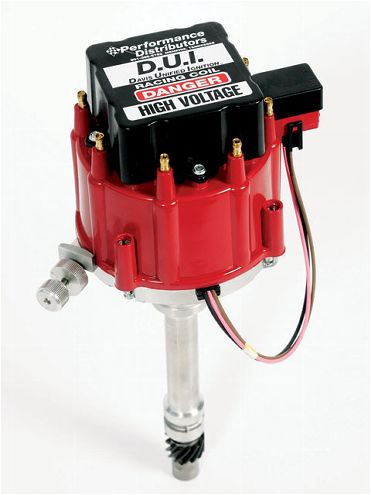 The ignition and carburetor are rarely part of the claim, so it's safe to invest your money in these components. Jeff Hill of Jeff's Performance says he recommends a racing HEI distributor like this one from Davis Unified Ignition (Performance Distributors) because it produces a hot spark and is dependable and simple to install.
The ignition and carburetor are rarely part of the claim, so it's safe to invest your money in these components. Jeff Hill of Jeff's Performance says he recommends a racing HEI distributor like this one from Davis Unified Ignition (Performance Distributors) because it produces a hot spark and is dependable and simple to install.
If you are limited to stock components, anything you can do to lighten things up and reduce friction will help a lot. Grinding the stock 2.1-inch rod journal on the crank will reduce bearing speed and also cut friction. You can turn it down to 2.0 inches and use connecting rods from a 283 Chevy engine. The 283 was a popular engine from the mid-'50s on up, so it isn't hard to find.
Also, if you are sticking to stock parts, try to find a harmonic balancer from a Chevy 307. You can find 307's in Novas, Chevelles, and a lot of different pickup trucks between 1967 and 1973. The balancer from a 307 is about 4 pounds lighter than the stock balancer for a 350, and that will make a big difference in power hanging off the nose of the crank.
Ken TroutmanKT Engine Development
Checking your valvesprings will keep your engine running and help you avoid expensive failures. Since the rpm speeds have gone up, this is even more important. Get an on-head spring checker and start logging your spring rates. It's best to use your checker to log all the spring rates when the engine is brand-new, and then use the same spring checker every time. Different checkers may give you different readings, but you'll have consistency as long as you use the same checker.
Pull the valve covers and check your spring rates every couple of weeks. This way, you are more likely to detect a spring losing pressure before you have bigger problems. If a spring gets weak, the motor is going to run flat because it can't close the valve and keep it closed. If it gets worse a valve will hit the piston top, and the valve will break. That's when things get expensive.
We normally run springs that rate at 140 on the seat and 350 open. Running 1.6:1 rockers and an aggressive cam lobe is even harder on the springs, and you really have to stay on top of them. Anytime you see 10 pounds of drop, be aware that the spring is about to give up. When you see 20 pounds, go ahead and get it out of there.
Kent DavenportJR Motorsports
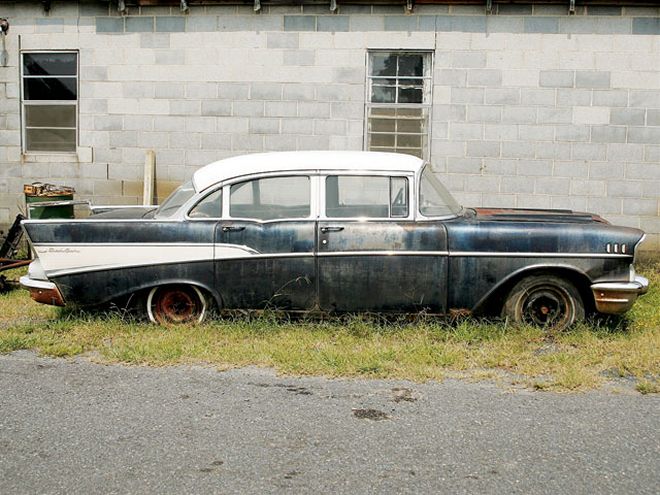 What does this well-worn '57 Chevy have to do with modern stock car racing? Not much, except that this is the beginning of Chevrolet's 283 V-8, which appeared in all types of Chevys for many years. These engines use a connecting rod with 2.00-inch journals. If your rule book requires stock rods, you can reduce some bearing speed (and friction) by turning down the rod journals from 2.10 to 2.00 inches and using rods for a 283.
What does this well-worn '57 Chevy have to do with modern stock car racing? Not much, except that this is the beginning of Chevrolet's 283 V-8, which appeared in all types of Chevys for many years. These engines use a connecting rod with 2.00-inch journals. If your rule book requires stock rods, you can reduce some bearing speed (and friction) by turning down the rod journals from 2.10 to 2.00 inches and using rods for a 283.
If you want to avoid problems, I always recommend running a good engine oil and looking at your oil filter every other week. Get a filter cutter, cut the metal can off the filter, and take a good look at the filter material. As long as there is no contamination, your engine is fine. When you find contamination in your oil filter, you know you have some wear. We have seen some go all season without anything harmful in the oil filter, and we don't mess with them. If you start seeing fine particles, either aluminum or steel, you either have a bearing going away or problems with a piston.
Your breathers will also give you a good clue as to the health of your engine. If you are not seeing any blow-by out of the breathers, the rings are still sealed and you should be making good power. You should also do a compression test every week. While you are at it, pull the valve covers and check the spring pressures and your valve lash. If you aren't seeing anything there, then your engine is still doing well and you can go racing.
Jeff Hill
Jeff's Performance
Stock or stock replacement balancers are normally bonded together with a rubber ring. It is possible for those balancers to move on the ring because of the bonded surface. If that happens, your timing marks will be misaligned. We recommend marking the inner and outer steel rings on the balancer either with paint or center punches. Make sure the two marks are in line. Check the timing marks to see if they have moved. If the marks aren't lined up, you can't set the timing correctly. When those marks don't line up, it is time to replace that balancer.
Kent Davenport
JR Motorsports
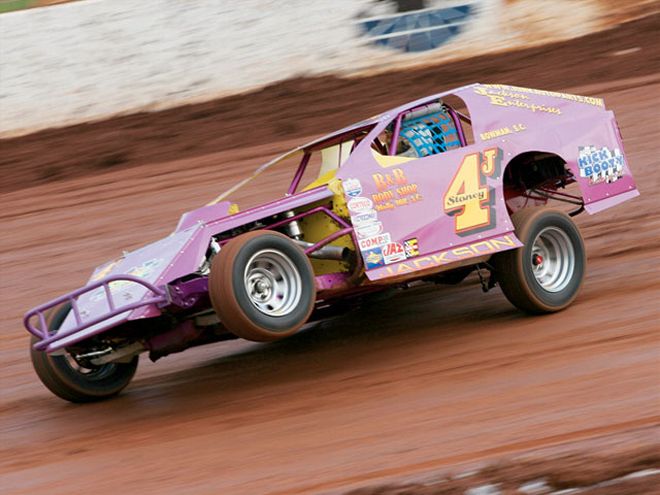
According to the claim rules, someone can buy your engine, but you get to keep the carburetor and ignition. Since they can't claim those pieces, you can safely invest in good equipment that can help you make power. When it comes to the ignition, I think it's hard to beat the old HEI alternator from Performance Distributors. It makes a strong spark, and it's dependable and simple.
The other thing is the carburetor, which is critical to making good power. The biggest problem is just about every racer takes off the carburetor, lays it on the bench, spends thousands of dollars to put the best of everything inside the engine, and then bolts the carburetor back up without a thought. But a lot of times the carburetor is holding back more power than anything.
If I had a choice between racing a decent claimer motor with a nice, tuned carburetor versus a $10,000 engine with a piece of junk carb, I'd take the claimer any day because it will smoke the 10-grand motor. A good carburetor is that important.
Jeff Hill
Jeff's Performance
If you are allowed to run it, you should definitely try a Vortec cylinder head. They easily make the most power. With the same engine, you will see a 50hp gain versus any other stock GM cylinder head. Plus, new aftermarket Vortec heads are really reasonable. We are using a lot of the Vortec heads from EQ Cylinder Heads. They are a really nice piece and make good power. For the money and the power, they are unbelievable. Normally, with the Vortec heads you have to use a specific intake manifold and exhaust headers, but I know EQ is coming out with a head that1s drilled so it can accept any 23-degree intake manifold. Jeff Hill
Jeff's Performance